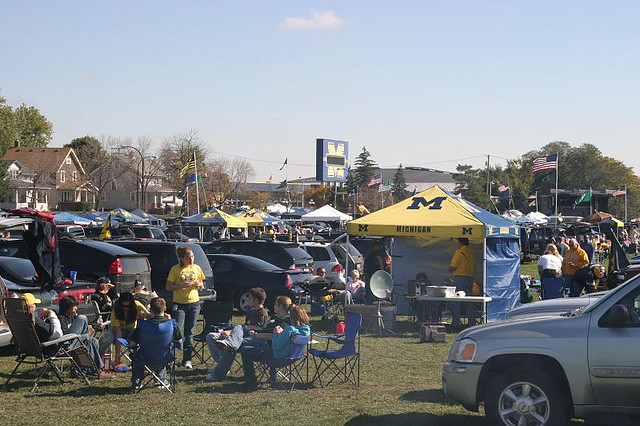The 150th season of college football serves as a reminder of the intersection between sports and local communities. While the nationalization of sports media outlets brings games and analysis to every living room in America, fan culture retains a very distinct regional and local flavor.
College football is one of the greatest testimonies to the endurance of localism in America today. The base of college football fans comes primarily from outside the Washington DC – New York City megalopolis that dominates the mainstream media’s attention. In the past few seasons, the two dominant programs in college football, Alabama and Clemson, are located in relatively small cities in the Deep South. And despite the efforts of conferences like the Big Ten to bring Rutgers and Maryland into a predominantly Midwestern conference, the Northeast remains relatively uninterested in college football.
The Power Five conferences in college football represent, largely, distinct regions of the country. The Southeastern Conference (SEC) is synonymous with the South, the PAC 12 is a West Coast conference, the Midwest has the Big Ten and the Farm Belt has the Big 12. The ACC includes several Northeastern members (Pitt, Boston College and Syracuse), but is primarily a Southern conference. The schools in each conference have historic rivalries, oftentimes based on geographical proximity.
The biggest rivalries in college football are between schools in the same state, like Alabama and Auburn, or schools in adjacent states, like Michigan and Ohio State or Oklahoma and Texas. These types of traditional rivalries give the games tradition and meaning and create a sense of tribalism among alumni bases and fans. Based on personal experience living in Ohio, after growing up in Michigan, I quickly observed the intensity channeled by Ohioans in support of the Buckeyes (and hostility toward “The State Up North”). Ohio is a unique place in the college football world in that there is no major in-state rival. While Michiganders are often divided between Wolverines and Spartans, Ohioans from Cincinnati to Youngstown are singularly focused on the Buckeyes with a sort of religious fervor.
In a state like Florida, fan allegiance is more decentralized. Three major programs including Florida, Florida State, and Miami all have sizable fan bases. Recent success by UCF has broken down those loyalties even further. Large states like Texas and California with several major programs have similar dynamics. Loyalties to college football programs are formed in a number of ways. Alumni make up a large portion of these fan bases, but certainly not exclusively. The loyalties inherited from fathers and grandfathers, geographic location, and the success of a program during a fan’s formative years all play into a fan’s psyche.
College football even creates arguments among regions in terms of conference performance and dominance. Debates about strength and performances of the conferences themselves is commonplace. Take Paul Finebaum, who built his reputation as a radio personality covering the college game in Alabama. Finebaum has gone nationwide in recent years, doing work with ESPN and is the headliner of the SEC Network. In 2015, Finebaum wrote his manifesto entitled My Conference Can Beat Your Conference: Why the SEC Still Rules College Football, cementing his reputation as an SEC partisan. The Finebaum approach to conference loyalty has spread across college football, as Power Five conference coaches and fans delight in pointing out the flaws they detect in other conferences and their programs. Such rhetoric further heightens the regionalism that marks college football.
While these trends of localism and regionalism are prominent in college football, they are not exclusive to the sport. Baseball was referred to as America’s “National Pastime” in the middle part of the 20th century, but one national sports commentator in recent years called baseball “our best local sport.” What the commentator meant by this is that baseball’s 162 game schedule with local market broadcasting of games makes it more conducive for a regional audience to follow their local teams. While national networks like ESPN and Fox Sports broadcast select weekend games, the vast majority of baseball games are viewed (or listened to) through local media outlets. Other commentators have suggested this is one of the reasons MLB produces fewer universally known “stars” who garner the attention of their counterparts in the NFL or NBA. Baseball fans who follow their local teams know their players up and down the roster, but they may not know most of the players on teams in cities in far off parts of the country.
Similarly to college football, baseball’s historic rivalries also add intensity to the game and are based primarily on geographic proximity. The rivalry between the New York Yankees and the Boston Red Sox is considered by many to be the most intense in all of sports. The cities are separated by just over 200 miles. On the West Coast, the San Francisco Giants and LA Dodgers have a rivalry dating back to when they played in Manhattan and Brooklyn. Since both franchises relocated to California in the 1950s, they remain bitter intra-state rivals, separated by a nearly 400 mile stretch on Interstate 5. The cities of Chicago and St. Louis are situated approximately 300 miles apart, with only downstate Illinois between them. Cubs and Cardinals loyalties are dividing lines throughout the Prairie State. In all three cases, these teams play in the same division, meaning they play 18 games per season against each other.
These examples from college football and Major League Baseball provide a snapshot of how team loyalties fragment the vast American landscape. Recently, I had my first experience attending a Major League Soccer match here in Orlando. While I have limited knowledge of soccer, I was blown away by the intensity of the crowd and the pageantry of the event. Orlando City SC began play as an expansion team in 2015, and they have already attracted a loud and loyal fan base. The team has two “supporters clubs” that occupy the area known as The Wall at Exploria Stadium. The Wall is a standing-only section behind the goal on the south end of the stadium. Flag waving, drum beating, and chants are seen and heard throughout the duration of the match. I have just begun to consider soccer fanaticism, but my limited experience indicates it’s a powerful force—and one that deepens regional identities.
After the Indianapolis Colts quarterback Andrew Luck announced his retirement, he took out a full page ad in the Indianapolis Star to thank Colts fans. In this message, a man who went to high school in Texas and college at Stanford wrote, “I’m proud to be a Midwesterner, a Hooiser, and a Colt.” Luck’s message was not addressing all of America or the pundits in the national sports media, it was intended for football fans in the state of Indiana.
If sports fandom teaches us anything about our culture, it is that America may not simply be “one nation,” but many regions. In fact, when sports becomes nationalized in America, it tends to get messy and most often political. Think about recent disputes over NFL players kneeling in protest of the national anthem or the US women’s soccer team chanting for “equal pay.” This may be why sports fans prefer to root for local and regional teams rather than national ones. Fans demonstrate their support through their commitment to their school or their city’s franchise, and through opposition to their rivals. While politics today may ask Americans to choose between two factions who battle for control of the levers of national government, this binary choice does not really reflect the way people live and associate within their states and localities. Sports fanaticism may be the best representation of real federalism in America today.






7 comments
Brian D. Miller
Brian,
On my other, slightly less contrarian, hand… I have fond memories of us walking through our working-class neighborhood in Knoxville many years ago. We’d be heading out to watch the Knoxville Blue Jays play in Bill Meyer stadium (now torn down). The journey was about six blocks. Along the way we’d stop and visit with friends on their front porch, who often as not would come down and join us.
It was pretty magical to have that stadium in the neighborhood. The left field wall was the Standard Knitting Mill. On break time there would be dozens of mill workers hanging out the open windows, smokes in one hand, cheering on the action on the field.
That had a strong localism core, that stadium. Of course, years later they tore it down to move it to the suburbs chasing dollars. One of their more successful promotions was the monthly Church Bulletin night. Bring a copy of your church bulletin and get in for half price. They would count the bulletins and announce the winner, the church with the most attendees. Always fierce bragging rights among the local churches.
What a great way to spend a fall evening, beer in one hand and a hot dog in the other, chatting with friends.
My best,
Brian Miller
Brian Koss
This is a great memory you shared! Old stadiums were often built this way, attached to a neighborhood. Like Tiger Stadium was in the Corktown area of Detroit. I am a huge fan of Minor League Baseball. It’s actually the primary focus of our work at Legends on Deck.
Barbara Castle
Brian,
Your observations about human behavior are insightful. Our regionalism in sports is useful to our well-being (apart from the corruption mentioned by Miller when the “telos” is infringed upon by capitalism, politics, etc). I think we “act out” rivalry as catharsis in sports which helps to avoid real-life violence. It is a much needed release valve. Even though it drives local education today (which gives the false read-out on the purpose of education) — this too is a distortion of the “good” it can bring to a community. As a widowed mom, it was sports and the coaches that were surrogate fathers for my boys. They taught them character, sportsmanship, teamwork, skill, attitude adjustment, as well as brought discipline to their lives. One of my boys attended a public school, the other one a Christian private school — both included leadership that inculcated the spiritual as well as the gritty practicalities of hormonal-driven youths. High-school sports is something that is a communal good for the most part — returning to us young men with a lot of stories to tell (which gives our lives meaning). In this way, early-on, local sports are more personal and individual. I suppose that regional college sports functions differently in that as you say it “deepens regional identify.” The first step is an individual “to” the community and secondly the “community” to the region. At any rate you have given us some interesting considerations today.
Brian Koss
Barbara, thank you for reading and for the comments! That was my whole point of the article, to give the reader some interesting things to consider. I thinks sports can have a lot of positive impacts, building local community is one of the big ones in my mind.
Brian Miller
I’m feeling a bit contrarian with this post, Brian. When I think of college and high school teams (not to mention professional teams) something else comes to mind:
• Misallocation of community tax dollars
• Misdirection of the populace as to the purpose of education
• Corruption and cheating scandals in the pursuit of entertainment
• Bread and Circuses for an increasingly brain-dead citizenry
Me? I’d rather invite friends and neighbors out to the farm for a dinner and conversation on a Saturday evening than turn on the TV and root for the above.
Just sayin’
Brian Koss
All good points, Brian. I cannot argue with you on the corruption that exists in college athletics, particularly in regards to recruiting and the money raised by the programs. But, I think these are separate issues. While you may not personally relate to the fanaticism, my goal was primarily to bring attention to what it is and how it impacts the culture. Appreciate you reading and the feedback!
Brian
Well, most educational institutions of today have been grossly perverted from anything like “the purpose of education” so I’m not sure where they could go much worse. Colleges today actually do a relatively good job at creating a sense of community, but my suspicion is that that’s because of the formative ages of students.
Back to sports, as with most everything else, they’d benefit from a move towards the local and the small. I think it’d be salutary to move professional sports to a club system rather than franchises. That would eliminate most of the sort of extortionate behavior that has become common in the last few decades.
Comments are closed.